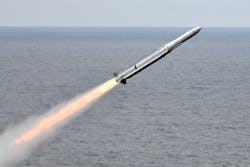Raytheon set to build more RIM-162 ESSM Block 2 shipboard missiles that offer increased maneuverability
WASHINGTON – Missile experts at Raytheon Technologies Corp. will continue building next-generation shipboard missiles through 2023 that can defeat a wide variety of aircraft and missile threats with an active radar seeker than can operate independently of the launch ship under terms of a $269 million order announced Tuesday.
Officials of the U.S. Naval Sea Systems Command in Washington are asking the Raytheon Missiles & Defense segment in Tucson, Ariz., for 2021-2023 RIM-162 Evolved Seasparrow Missile (ESSM) Block 2 full-rate production from 2021 to 2023.
The ESSM Block 2 first was deployed with the Navy and allied navies last year. It is a ship self-defense missile with a dual-mode X-band radar seeker than can engage enemy planes and missiles at ranges beyond 25 miles. RIM stands for radar intercept missile.
Compared with its ESSM Block 1 predecessor, the ESSM Block 2 has increased maneuverability and other enhancements that enable the missile to defeat future threats to U.S. and allied navies operating in hostile environments, Raytheon officials say. The ESSM Block 2’s active seeker will support terminal engagement without the launch ship’s target illumination radars.
In addition to the U.S. Navy, the governments of Australia, Belgium, Canada, Denmark, Germany, Greece, The Netherlands, Norway, Portugal, Spain, and Turkey will operate ESSM Block 2 anti-air missile.
ESSM is a medium-range, semi-active homing missile that makes flight corrections via radar and midcourse data uplinks. The missile provides reliable ship self-defense capability against agile, high-speed, low-altitude anti-ship cruise missiles, low velocity air threats like helicopters, and high-speed, maneuverable surface threats.
The missile is 12 feet long and has 10-inch-diameter control and rocket motor sections that tapper to an 8-inch-diameter guidance section with a radome-protected antenna for semi-active homing and a warhead. It has a high-thrust, solid-propellant rocket motor and tail control via a thrust vector controller.
The first production ESSM Block 1 was delivered in late 2002 and has been in full operational use in the U.S. since 2004.
Raytheon will do the work on this contract in Tucson, Ariz.; Edinburgh and Eight Mile Plains, Australia; San Jose, Torrance, and Westlake Village, Calif.; Raufoss, Norway; Mississauga, Newmarket, and Cambridge, Ontario; Ottobrunn, Germany; Nashua, N.H.; Hengelo Ov, The Netherlands; H Koropi Attica, Greece; Canton, N.Y.; Ankara, Turkey; Grenaa and Lystrup, Denmark; Madrid; Milwaukie, Ore.; Lawrence, Maine; and Clearwater, Fla., and should be finished by March 2025.
For more information contact Raytheon Missiles & Defense online at www.raytheonmissilesanddefense.com, or Naval Sea Systems Command at www.navsea.navy.mil.

John Keller | Editor-in-Chief
John Keller is the Editor-in-Chief, Military & Aerospace Electronics Magazine--provides extensive coverage and analysis of enabling electronics and optoelectronic technologies in military, space and commercial aviation applications. John has been a member of the Military & Aerospace Electronics staff since 1989 and chief editor since 1995.

